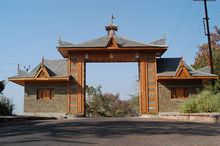
National Museum of Man (Indira Gandhi Rashtriya Manav Sangrahalaya)

National Museum of Man (Indira Gandhi Rashtriya Manav Sangrahalaya)
Bhopal, Madhya Pradesh
India 462 013
M: 0755- 2661319, 2661458
F: 542076, 540319, 545670, 541369, 5402
Indira Gandhi Rashtriya Manav Sangrahalaya is an autonomous organisation of the Ministry of Culture, Govt. of India. Unlike other walled museums of post colonial period, this museum breaks away the conventional norms, providing an opportunity to experience the cultural heritage of the country through its open air and indoor exhibitions and activities organised across the country. In the beginning it was established as a sub-ordinate office under the Department of Education, Govt. of India at Bahawalpur house which was looked after by Anthropology Survey of India. Conceived in the early 1970s, the IGRMS began its activities in 1977 by opening a nucleus office at New Delhi. The establishment was shifted to Bhopal in early 1979. A Southern Regional Centre of IGRMS is functioning since 2001 at Mysore from a heritage building ‘Wellington House’. An active involvement of traditional artisans and experts from different community groups, Education, Outreach and Salvage activities for revitalisation of vanishing cultural traditions forms objectives of this museum.
About the collection: The Museum has over 25000 ethnographic objects divided under 17 categories namely, (i)Agriculture, (ii)Animal husbandry, (iii)Games and amusement, (iv)hunting (v) fishing, (vi)house hold, (vii)Ritual, (viii)Musical, (ix)Textile, (x)travel and transport, (xi)Tools and equipment, (xii) Weapons, (xiii) Art and Craft, (xiv) Basketry, (xv) Spinning and Weaving, (xvi) Ornaments, (xvii) Narcotics. Open-air exhibits of tribal communities of India also form the strength of this museum. 12 objects in AA and 52 in A category are also registered in National Register for their rareness, artwork, shape, uniqueness and aesthetics.